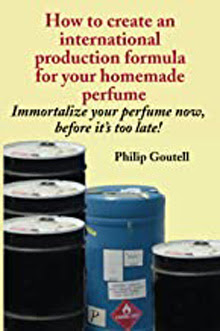
L'Air de Temps (1948, by Roure perfumer Francais Fabron for Nina Ricci) is a perfume out of the past. You won't generally run into it at the mall, at least not in an older version that uses all those wonderful aroma materials that are restricted or banned or just too expensive to use in a perfume today.
A few years ago I had the good fortune to come across an older, unopened, bottle which I purchased and gave to my wife. Spending a DAY with her when she was wearing it was a great experience. That fragrance had both beauty and tenacity.
Last week I was reviewing the ten blocks of online lessons that are part of the PerfumersWorld Foundation Course In Creative Perfumery in order to write a new ad for the course. Of course I had studied all of these lessons before as it was this course that launched my own efforts in creative perfumery but to write about the course I needed to study the lessons again. This time when I came across the lesson on L'Air du Temps it had new meaning for me.
L'Air du Temps is regarded as the "classic" CARNATION perfume. The course discusses both the use of the accord that gave it it's special character (a blending of Benzyl Salicylate, Eugenol, and Musk Ketone) and it's overall structure. Two separate "sample" formulas are given to demonstrate how this TYPE of fragrance -- classic carnation -- is constructed.
These formulas are not given to help you create knockoffs and they are not intended to be "true" formulas for L'Air du Temps. They appear in this lesson as student learning exercises, to show you HOW various aroma materials, which DO NOT smell of carnation, come together in a beautiful carnation fragrance.
While one of the formulas in the lesson requires the use of aroma materials the beginning student is NOT likely to have on hand, the other uses ONLY materials supplied with the course and can immediately be mixed by anyone taking the course. (All this is in lesson block #10 so a bit of patience is needed to get to it.)
Now I've mixed the simple version of the formula on several occasions and I can tell you that it certainly DOES give you a taste of the experience you would get with the "real" L'Air du Temps. And, laying the simple formula side by side with the more advanced formula, you get an idea of WHAT aroma materials have what effect on the composition.
For example, in the more advanced formula, "Spice" Fleuressence (the "S" in the ABC's of Perfumery) is replaced by a blending of three aroma materials: Eugenol, iso-Eugenol, and Clove Bud Oil. So now, looking at the two formulas side by side, you begin to understand that "Spice" Fleuressence characterizes an odor group and that Eugenol, iso-Eugenol, and Clove Bud Oil fall into this grouping.
If you are curious about the odors involved, you can simply purchase small amounts of Eugenol, iso-Eugenol and Clove Bud Oil and, using your nose, make your own comparison. Likewise you can go through the other 12 materials in the simple version of the formula and explore their more "sophisticated" counterparts.
So this lesson has a double importance. In the first place you learn about the structure of a classic perfume and how materials that are not at all similar in aroma are blended into a distinctive and beautiful perfume.
Then in this lesson, the student is given a TRANSLATOR ... two formulas, side by side, that create perfumes with very similar aromas so that you can SEE how the aroma materials that you have on hand (from the K26 materials kit which is part of the Foundation Course) "translate" into combinations of the single chemical aroma materials that a professional perfumer would use.
Lessons like this are valuable when you are struggling to learn perfumery. Best of all, along the way, as student exercises, you get to make up some simple but really beautiful fragrances which can immediately be put to use.


